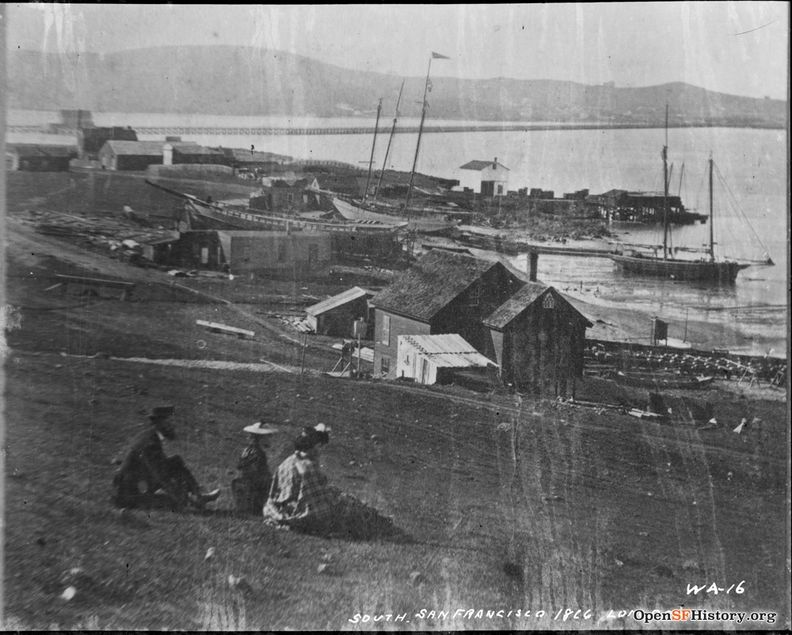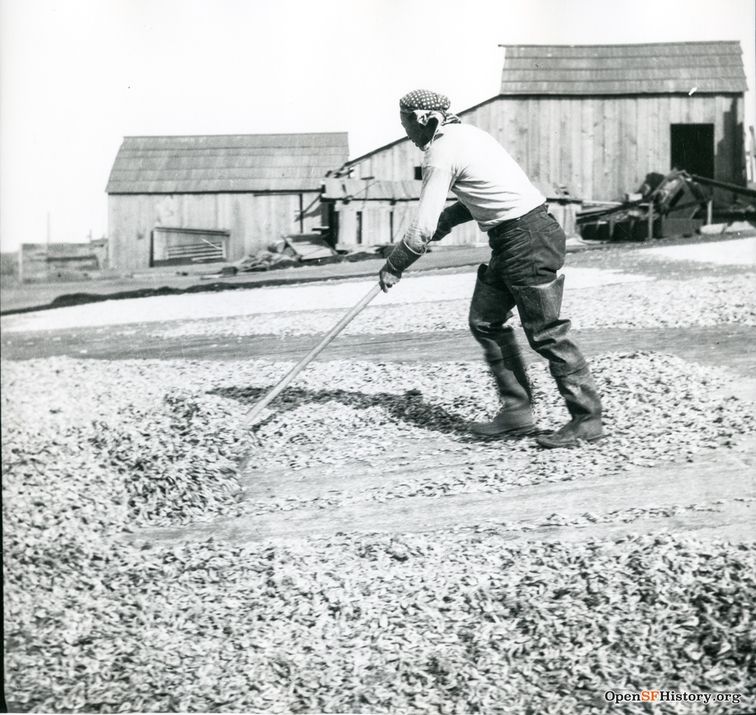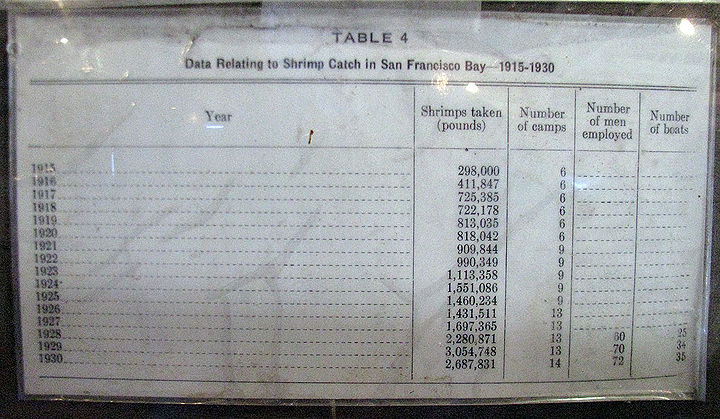Chinese shrimping village
Historical Essay
by Chris Carlsson (with a hat tip to David Gallagher)
White buyers peruse fresh shrimp on sale at the docks along India Basin in Hunter's Point, early 1930s.
Photo: China Camp State Park
Chinese shrimpers on San Francisco Bay, c. 1938
Photo: Online Library of California
View northwest in 1866 across mouth of Islais Creek marshes with southern part of Long Bridge crossing from Potrero Point to Hunters Point. Chinese shrimpers' abodes, ships, and nets are clearly visible along the shoreline in this photo.
Photo: OpenSFHistory.org wnp71.2239; GGNRA/Behrman GOGA 35346
The Chinese shrimping camp along the shores of India Basin on Hunter's Point just before its destruction in 1939.
Photo: courtesy private collector at OpenSFHistory
A community of Chinese shrimp fishermen made their home along the shores of India Basin on Hunter's Point until 1939, when the U.S. Navy took over the land under eminent domain for the Naval Shipyard. The Health Department came in and burned the shacks and docks that once provided a small village of fishermen and their families a steady living in the abundant shrimp harvest from the San Francisco Bay.
But that was not the first time the Health Department had come in and destroyed the livelihood of Hunter's Point shrimpers. The "Butchers' Reservation" was established in the Islais Creek marshes further west in the 1870s and by the 1890s new public health concerns with microscopic threats to public hygiene led to allegations that "Butchertown shrimp" were contaminated with ptomaine—a bacteria-produced protein laden in the tons of waste emanating from the slaughterhouses every day.
In 1899, the city's health officer, accompanied by the city's chemist and police officers, and a small brigade of Health Department inspectors invaded the Chinese encampment along the slopes of Hunter's Point and condemned and set fire to 15,000 pounds of shrimp. (Months later, the city's Board of Health admitted on page 7 of the San Francisco Call that the shrimp were not "germ-ridden" after all.)
Health Department burns Chinese shrimping village along shores of India Basin at Hunter's Point, April 20, 1939.
Photo: courtesy private collector at OpenSFHistory
From the beginnings of San Francisco's urban growth, Chinese immigrants established fishing villages around the Bay. The southern shores of San Francisco at Hunter's Point was one, but there were others too, especially at China Camp (Point San Pedro) in Marin County and directly east across the Bay at Point Pinole near Richmond. This map shows where they were in the 1880s:
Map: China Camp State Park
The Chinese fishermen sailed their redwood fishing boats to the mudflats. They dropped sail and set the large, triangular nets by staking them into the mud in long lines. The mouths of the nets were set open to the oncoming tide to catch shrimp swept along by the current. As the tide slackened, the fishermen raised nets and dumped the live shrimp into large baskets that were then stored in the boat’s hold. The nets were reset in the opposite direction for the next tidal cycle. After two tidal cycles, or about twelve hours, the holds were full and the fishermen returned to camp to process the catch.
Collage depicting a Chinese shrimping village at Rincon Point by Satty, from "Visions of Frisco" edited by Walter Medeiros, Regent Press 2007
Chinese shrimping village at southern foot of Rincon Hill, c. 1859.
Painting by Matilda F. Mott, courtesy California Historical Society
Along the shores of Hunter's Point Chinese shrimpers lived and worked one of the most fertile shrimping beds in the San Francisco bay. Chinese San Franciscans had dominated the shrimping industry in the region since the 1870s. By 1895 the 5.4 million pounds of shrimp harvested in the Bay Area—almost entirely by Chinese fishermen—was second only to the Bay Area oyster industry in market value and tonnage.
The Chinese “shrimp camps” that appeared in the 1870s were more than just work environments. Shrimp farmers often lived alongside the shores where they worked—sometimes in the very same structures. In some ways, the spatial isolation of these camps probably offered refuge for Chinese men, away from a discriminatory landscape downtown. To outsiders, however, the lives and work environments of Chinese shrimpers were improper. Not only did Chinese men live in the same places they worked in substandard conditions, but—even more shocking to white observers—Chinese men used their bare feet and wooden shoes to separate meat from the shells. Adding to white hostility, most of the shrimp were exported to China, where their meat was sold as inexpensive food and their pulverized shells as fertilizer. This export economy angered many whites, who saw the natural bounty of the bay sold away to China for the profit of the Chinese immigrants and merchants. To white observers, the whole operation was backwards. —Excerpted from Animal City: The Domestication of America by Andrew Robichaud, Harvard University Press: 2019
Chinese shrimper, c. 1910.
Photos: courtesy private collector at OpenSFHistory
Sweeping shrimp, c. 1910.
Processing shrimp for shipment to China was a big part of the business.
Photo: China Camp State Park
Hunter's Point was home to twelve different shrimp companies, each quite small (504 nets, 16 boats, 53 men working altogether), but along with shrimpers on other shores of the Bay, part of an incredibly productive shrimp fishery in the San Francisco Bay during 1920s. Here are the twelve companies at Hunter's Point, numbered to correspond to the location along the shore of India Basin in the map below:
1. Leuong Shui Shrimp Company
2. City Shrimp Company
3. Quong Fat Shrimp Company
4. Quong Song Shrimp Company
5. California Shrimp Company
6. Golden West Shrimp Company
7. Yip Fook Shrimp Company
8. See Hop Wo Shrimp Company
9. George Shrimp Company
10. Golden Gate Shrimp Company
11. Wing Hing Wo Shrimp Company
12. Quong Duck Chong Company
For full map and extensive description of shrimping visit the Division of Fish and Game of California document on the California Shrimp Industry.'
Here are the statistics of San Francisco Bay shrimp production from 1915-1930, in the original Fish & Game table below:
Image: China Camp State Park
Image: China Camp State Park
In 1939 the Health Department burned the remaining structures to make way for the Navy.
Photo: Private Collection, San Francisco, CA
'No Shrimp Today' sign after last days of shrimp sales at Hunter's Point camp, April 1939.
Photos: courtesy private collector at OpenSFHistory
Chinese fishermen in San Francisco Bay, 1875.
Image: Harper's Magazine



















